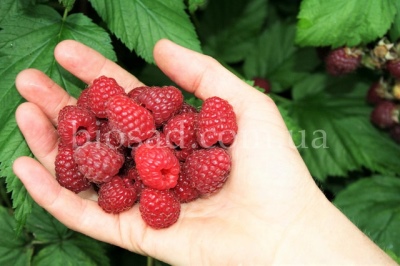
- Authors: Supermalina kennel, Moscow region, Russia
- Repairability: Yes
- Berry color: raspberry
- Taste: sweet and sour
- Ripening period: mid-early
- Berry weight, g: 15-20
- Yield: 5-12 kg per bush
- Frost resistance: high
- Fruiting period: early July-August
- Keeping quality: good
Standard raspberry Bogatyr is a relatively new variety. The plant was bred in the supermalina nursery near Moscow. Every year there are more and more fans of this variety.
Description of the variety
The bush has a size in height of 180-200 cm, compact. Shoots are strong, powerful, erect. The internodes are shortened, the thorns are absent.
Ripening terms
Raspberry Bogatyr belongs to medium early remontant varieties. The first berries can be tasted at the beginning of July. At the same time, the harvest does not ripen at the same time - from July to the end of August, 5 harvests of fruits are possible.
Yield
The productivity of the presented variety is very high, 6-12 kg of berries can be harvested from one bush.
Berries and their taste
The fruits are raspberry-colored and cone-shaped. The berries are large, their weight reaches 15-20 g. The taste is pleasant, sweet and sour, and a pronounced aroma is also characteristic of the fruits. The raspberry crop Bogatyr has excellent keeping quality and good transportability.

Growing features
When planting this variety, the following factors should be considered:
it is a drought-resistant variety, but timely watering will ensure a successful harvest;
despite the high frost resistance, in regions with a harsh climate and a small amount of snow, the crop is covered with agrofibre for the winter to protect the ground part from freezing;
do not plant raspberries in soil that is even slightly acidic, add lime before planting to reduce the acidity level;
avoid growing this variety in a region with a short summer, as the berries will not have time to ripen.
Site selection and soil preparation
The most favorable land for planting such raspberries should be fertile and moderately moist. The amount of lime added is about 0.5 kg per 1 sq. m. Make sure that the ridge was removed from the place of occurrence of groundwater. Raspberry Bogatyr will feel comfortable in a well-lit area.
It is best to plant a shrub in the place where peas, beans, beans, parsley, dill, garlic, and onions used to grow. Avoid garden beds that previously contained potatoes, peppers, and eggplants.


Pruning
This bush requires a standard formative pruning. It is important to pinch the top of the main trunk by 10 cm. For aesthetics, lateral fruiting branches with root shoots are removed.These actions are carried out closer to the middle of autumn. In the spring, the sprouts damaged during the winter are eliminated near the bush.
The standard variety can form replacement shoots. If all the shoots are removed and left alone, you will get a plant in the form of a tree that can withstand the weight of large fruits and will firmly endure gusts of wind. If you leave the growth near the bush and allow it to grow, then the likelihood of a successful harvest decreases.

Watering and feeding
This variety does not like abundant moisture; in dry times, it is enough to water the trees 4 times a month. The amount of water is one bucket per bush. It is important to moisten the soil during the fruit setting period - during this time the culture spends a lot of energy. If watering is completely neglected, then this will not affect the taste of the berries, but they can turn out to be small. Usually, to moisturize the area where Bogatyr raspberries are kept, gardeners recommend using the drip irrigation method.
The bush needs fertilization three times per season.
The first feeding is in the spring before flowering. During this period, a urea solution is used as an additive (20 g per bucket of water), a liter for each instance. You can compost the crop around it.
The second time the tree is fertilized when the berries form. Potassium will be appropriate during this period.
The last feeding is carried out in the fall, phosphorus is used for this.



Diseases and pests
The variety is considered resistant to anthracnose, verticillium and didimella. But spider mites or gall midges should be feared. To prevent ailments, you can use a double treatment: in the spring, BI-58 is relevant, in the fall - Bordeaux liquid 3%.

Unfortunately, raspberries, like other plants, do not bypass various diseases and pests. Only armed with the knowledge and the necessary means for this, you can cope with such troubles. To help the plant, it is very important to be able to recognize the disease in time and begin timely treatment.
Reproduction
Breeding such raspberries is possible in two ways.
Bygrowth. To do this, separate the processes along with the soil and plant them in another place. The harvest can be expected next season.
Cuttings. To do this, you need to dig in a bush and separate the root cutting with buds. Place it in a sandy-peat substrate for it to take root. The next year, the seedling can be transplanted into open ground.








































































